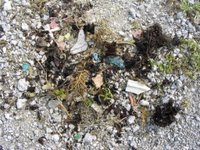
Today's LA times article,
Plague of Plastic Chokes our Seas gets to the heart of what first inspired my fascination with plastic waste:
The stuff is slowly but surely filling our vast, "unspoilable" oceans.
The article mentions
Captain Charles Moore, one of the leading experts/activists on oceanic plastics. I first heard Charles speak at the 2002 World Oceans Conference in Santa Barbara, and saw his chilling documentary
"Our Synthetic Sea", detailing the devastating impacts plastic pollution has on marine ecosystems.
For weeks, I was haunted by his presentation, especially his findings of
ratios of 6 to 1, plastic to plankton in various ocean regions. Thats
6 times more plastic than plankton - the critical base of the entire marine foodchain....
I had to see for myself.

So I joined Captain Moore on a 2 week research trip to Guadalupe Island, to collect stomach samples from juvenile Laysan Albatross - the Captain and part of the femme crew in photo to the right.
Which entailed traipsing around this remote island looking for "boluses", the undigested material regurgitated by the chicks - normally squid beaks and such. This photo here shows the remains of a bolus - the dark material is squid bits, the rest - bits of plastic......

These boluses are excellent indicators of humans impact on natural food chains. Every last one of the samples we collected contained anywhere from 30-60% plastic.
This image from the Shifting Baselines website lays it out very clearly.
It's difficult to avoid cliche when talking about how "the little stuff adds up", but here, truly the case - a single lighter, pen cap, balloon, or plastic gadget can spell disaster for a hungry creature with an unrefined palette.
All fairly depressing, but nice to see the issue is beginning to get the coverage it warrants.....




